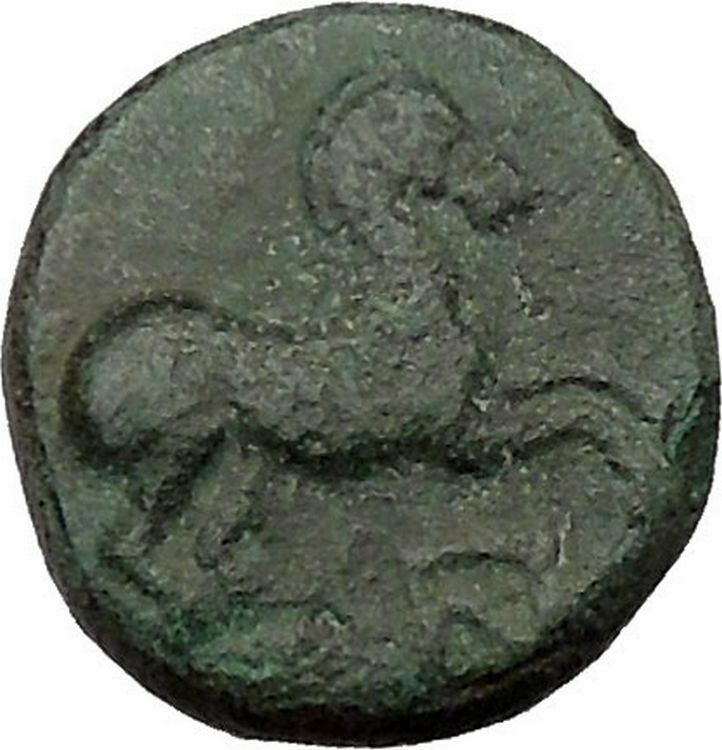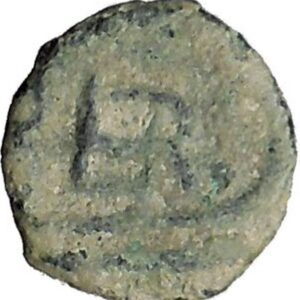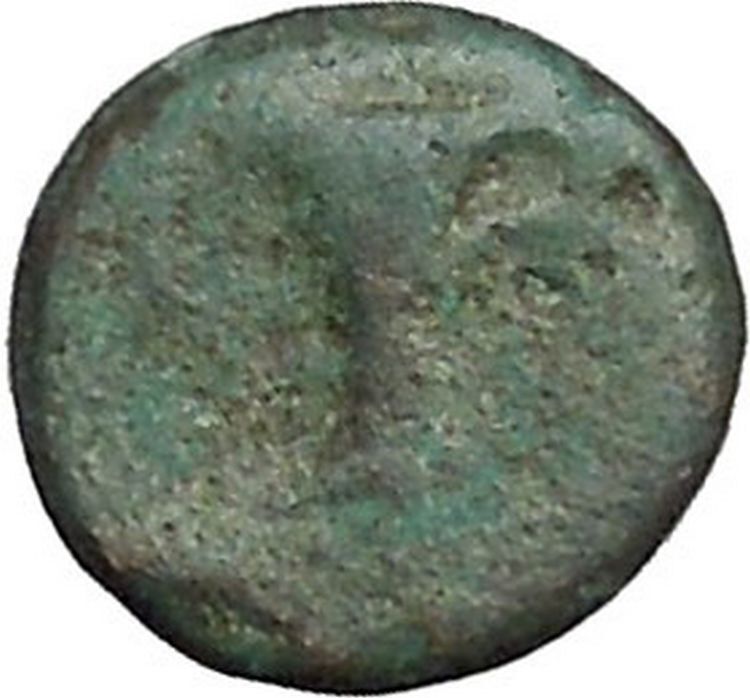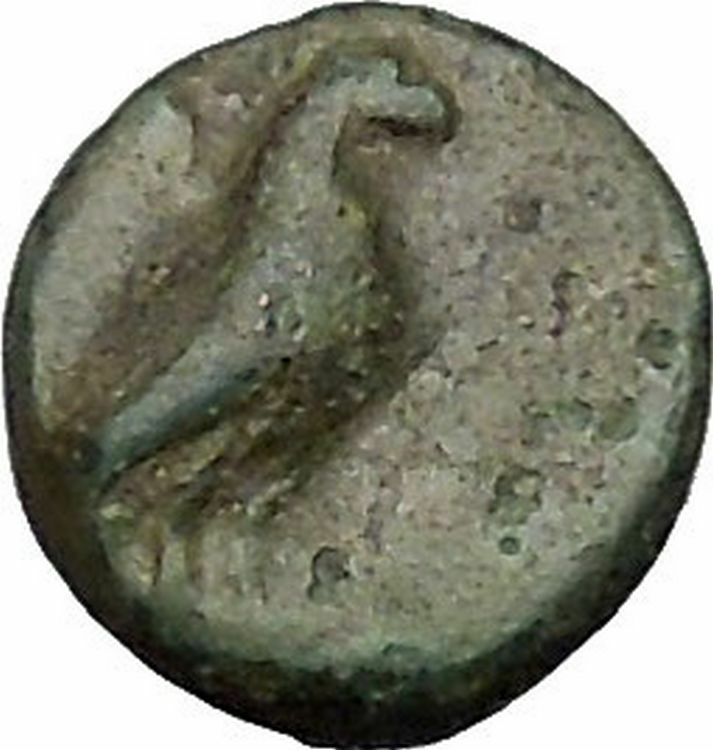|
Greek city of Gergis in Troas
Bronze 9mm (0.93 grams) Struck circa 350-241 B.C.
Reference: Sear 4099 var. (size); SNG von Aulock 1513; BMC 2-4.
Certification: NGC Ancients XF 4936004-005
Facing laureate head of Sibyl Herophile, head turned slightly right decorated with two long ear-pendants and pearl-necklace.
Sphinx seated left; ΓEP in field to right.
The Sibyl played an important role in antiquity. The first recorded use of the name Sibyl was in the fifth century BC. Originally Sibyl was the name given to a single prophetic woman. However the name became generic, and Sibyl was used to identify a woman who could prophesize. The Sibyls were most commonly associated with Apollo, who provided them with divine insight into the future. They were highly revered, and there work was accumulated in a corpus called the Sibyline books. This collection was housed in the Capitoline Temple of Jupiter., where they could only be consulted by the senate. The interest in sibyls throughout the Mediterranean world most likely stemmed from their close connection with Rome and the Sibyline corpus. The Sibyl Herophile was one of the ten Sibyls commonly known. She was a daughter of a nymph and a mortal. Herophile was meant to have been born near Gergis, at Marpessus, and her tomb was in the temple of Apollo at Gergis. Gergis was one of the three cities known to commemorate Sibyls on their coins. Her appearance on coins from Gergis would be a way of paying tribute to Herophile as well as indicating the important location of Gergis in terms of its proximity to the resting place of divine Sibyl. Herophile was said to have predicted the fall of Troy. She gave her prophecies in verse, and she delivered them standing on a stone which she always carried with her.
You are bidding on the exact item pictured, provided with a Certificate of Authenticity and Lifetime Guarantee of Authenticity.
The oldest collection of Sibylline utterances, the Sibylline Books, appears to have been made about the time of Cyrus at Gergis on Mount Ida; it was attributed to the Hellespontine Sibyl and was preserved in the temple of Apollo at Gergis. From Gergis the collection passed to Erythrae, where it became famous as the oracles of the Erythraean Sibyl. It seems to have been this very collection, or so it would appear, which found its way to Cumae (see the Cumaean Sibyl) and from Cumae to Rome.
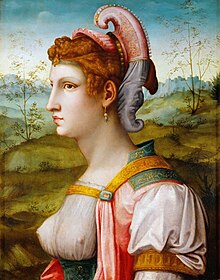 The sibyls were women that the ancient Greeks believed were oracles. The earliest sibyls, according to legend, prophesied at holy sites. Their prophecies were influenced by divine inspiration from a deity; originally at Delphi and Pessinos, the deities were chthonic deities. In Late Antiquity, various writers attested to the existence of sibyls in Greece, Italy, the Levant, and Asia Minor. The sibyls were women that the ancient Greeks believed were oracles. The earliest sibyls, according to legend, prophesied at holy sites. Their prophecies were influenced by divine inspiration from a deity; originally at Delphi and Pessinos, the deities were chthonic deities. In Late Antiquity, various writers attested to the existence of sibyls in Greece, Italy, the Levant, and Asia Minor.
The English word sibyl comes – via the Old French sibile and the Latin sibylla – from the ancient Greek Σίβυλλα (Sibulla). Varro derived the name from theobule (“divine counsel”), but modern philologists mostly propose an Old Italic or alternatively a Semitic etymology.
History
The first known Greek writer to mention a sibyl is Heraclitus, in the 5th century BC:
The Sibyl, with frenzied mouth uttering things not to be laughed at, unadorned and unperfumed, yet reaches to a thousand years with her voice by aid of the god.’
Walter Burkert observes that “frenzied women from whose lips the god speaks” are recorded very much earlier in the Near East, as in Mari in the second millennium and in Assyria in the first millennium”.
Until the literary elaborations of Roman writers, sibyls were not identified by a personal name, but by names that refer to the location of their temenos, or shrine.
In Pausanias, Description of Greece, the first sibyl at Delphi mentioned (“the former” [earlier]) was of great antiquity, and was thought, according to Pausanias, to have been given the name “sibyl” by the Libyans. Sir James Frazer calls the text defective. The second sibyl referred to by Pausanias, and named “Herophile”, seems to have been based ultimately in Samos, but visited other shrines, at Clarus. Delos and Delphi and sang there, but that at the same time, Delphi had its own sibyl.
James Frazer writes, in his translation and commentary on Pausanias, that only two of the Greek sibyls were historical: Herophile of Erythrae, who is thought to have lived in the 8th century BC, and Phyto of Samos who lived somewhat later. He observes that the Greeks at first seemed to have known only one sibyl, and instances Heraclides Ponticus as the first ancient writer to distinguish several sibyls: Heraclides names at least three sibyls, the Phrygian, the Erythraean, and the Hellespontine. The scholar David S. Potter writes, “In the late fifth century BC it does appear that ‘Sibylla’ was the name given to a single inspired prophetess”.
Like Heraclitus, Plato speaks of only one sibyl, but in course of time the number increased to nine, with a tenth, the Tiburtine Sibyl, probably Etruscan in origin, added by the Romans. According to Lactantius’ Divine Institutions (Book 1, Ch. 6), Varro (1st century BC) lists these ten: the Persian, the Libyan, the Delphic, the Cimmerian, the Erythræan, the Samian, the Cumæan, the Hellespontine (in Trojan territory), the Phrygian (at Ancyra), and the Tiburtine (named Albunea).
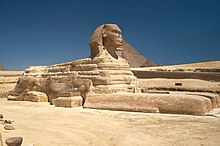 A sphinx is a mythical creature with, at a minimum, the head of a human and the body of a lion. A sphinx is a mythical creature with, at a minimum, the head of a human and the body of a lion.
In Greek tradition, it has the head of a human, the haunches of a lion, and sometimes the wings of a bird. It is mythicised as treacherous and merciless. Those who cannot answer its riddle suffer a fate typical in such mythological stories, as they are killed and eaten by this ravenous monster. This deadly version of a sphinx appears in the myth and drama of Oedipus. Unlike the Greek sphinx, which was a woman, the Egyptian sphinx is typically shown as a man (an androsphinx). In addition, the Egyptian sphinx was viewed as benevolent, but having a ferocious strength similar to the malevolent Greek version and both were thought of as guardians often flanking the entrances to temples.
In European decorative art, the sphinx enjoyed a major revival during the Renaissance. Later, the sphinx image, something very similar to the original Ancient Egyptian concept, was exported into many other cultures, albeit often interpreted quite differently due to translations of descriptions of the originals and the evolution of the concept in relation to other cultural traditions.
Sphinxes are generally associated with architectural structures such as royal tombs or religious temples. The oldest known sphinx was found near Gobekli Tepe at another site, Nevali Çori, or possibly 120 miles to the east at Kortik Tepe, Turkey, and was dated to 9,500 BCE.
 The Troad or Troas is the historical name of the Biga Peninsula (modern Turkish: Biga Yarımadası, Ancient Greek: Τρῳάς) in the northwestern part of Anatolia, Turkey. This region now is part of the Çanakkale province of Turkey. Bounded by the Dardanelles to the northwest, by the Aegean Sea to the west and separated from the rest of Anatolia by the massif that forms Mount Ida, the Troad is drained by two main rivers, the Scamander (Karamenderes) and the Simois, which join at the area containing the ruins of Troy. The Troad or Troas is the historical name of the Biga Peninsula (modern Turkish: Biga Yarımadası, Ancient Greek: Τρῳάς) in the northwestern part of Anatolia, Turkey. This region now is part of the Çanakkale province of Turkey. Bounded by the Dardanelles to the northwest, by the Aegean Sea to the west and separated from the rest of Anatolia by the massif that forms Mount Ida, the Troad is drained by two main rivers, the Scamander (Karamenderes) and the Simois, which join at the area containing the ruins of Troy.
Mount Ida, called by Homer “many-fountain” (πολυπίδαξ), sourced several rivers, including Rhesos, Heptaporos, Karesos, Rhodios, Grenikos (Granikos), Aesepos, Skamandros and Simoeis [Iliad 12.18 ff]; these rivers, were deified as a source of life by the Greeks, who depicted them on their coins as river-gods reclining by a stream and holding a reed.
History
The Troad gets its name from the Hittites’ name for the region, Taruiša. This identification was first put forth by Emil Forrer, but largely disputed by most Hittite experts until 1983 when Houwink ten Cate showed that two fragments were from the same original cuneiform tablet and in his discussion of the restored letter showed that Taruiša and Wiluša (Troy) were correctly placed in northwestern Anatolia. According to Trevor Bryce, Hittite texts indicate a number of Ahhiyawan raids on Wilusa during the 13th century BC, which may have resulted in the overthrow of king Walmu. Bryce also said that archeological surveys conducted by John Bintliff in the 1970s showed that a powerful kingdom that held sway over northwestern Anatolia was based at Wilusa (Troy).
Greek settlements flourished in Troas during the Archaic and Classical ages, as evidenced by the number of Greek poleis that coined money in their own names.
The region was part of the satrapy (province) of Hellespontine Phrygia of the Achaemenid Empire.
The Attalid kings of Pergamon (now Bergama) later ceded the territory of the Troad to the Roman Republic. Under the Roman Empire, the territory of the Troad became part of the province of Asia, and later of the smaller Mysian province Hellespontus; it was important enough to have suffragan bishoprics, including Pionia (now Avcılar).
Under the later Byzantine Empire, it was included in the thema of the Aegean Islands.
Following its conquest by the Ottoman Empire, the Troad formed part of the sanjak of Biga.
New Testament
The apostles Paul and Silas first visited Troas during their journey from Galatia to Macedonia.[4] Paul also referred to Troas when he asked his fellow worker Timothy out of Ephesus, to bring the cloak he had left there, a journey of about 500 kilometres (310 mi). The changes from the story, being recounted as “they” to “we” in Acts 16 and Acts 20, imply that Paul was joined by Luke when he went through Troas.
|









 The sibyls were women that the ancient Greeks believed were oracles. The earliest sibyls, according to legend, prophesied at holy sites. Their prophecies were influenced by divine inspiration from a deity; originally at Delphi and Pessinos, the deities were chthonic deities. In Late Antiquity, various writers attested to the existence of sibyls in Greece, Italy, the Levant, and Asia Minor.
The sibyls were women that the ancient Greeks believed were oracles. The earliest sibyls, according to legend, prophesied at holy sites. Their prophecies were influenced by divine inspiration from a deity; originally at Delphi and Pessinos, the deities were chthonic deities. In Late Antiquity, various writers attested to the existence of sibyls in Greece, Italy, the Levant, and Asia Minor. A sphinx is a mythical creature with, at a minimum, the head of a human and the body of a lion.
A sphinx is a mythical creature with, at a minimum, the head of a human and the body of a lion. The Troad or Troas is the historical name of the Biga Peninsula (modern Turkish: Biga Yarımadası, Ancient Greek: Τρῳάς) in the northwestern part of Anatolia, Turkey. This region now is part of the Çanakkale province of Turkey. Bounded by the Dardanelles to the northwest, by the Aegean Sea to the west and separated from the rest of Anatolia by the massif that forms Mount Ida, the Troad is drained by two main rivers, the Scamander (Karamenderes) and the Simois, which join at the area containing the ruins of Troy.
The Troad or Troas is the historical name of the Biga Peninsula (modern Turkish: Biga Yarımadası, Ancient Greek: Τρῳάς) in the northwestern part of Anatolia, Turkey. This region now is part of the Çanakkale province of Turkey. Bounded by the Dardanelles to the northwest, by the Aegean Sea to the west and separated from the rest of Anatolia by the massif that forms Mount Ida, the Troad is drained by two main rivers, the Scamander (Karamenderes) and the Simois, which join at the area containing the ruins of Troy.